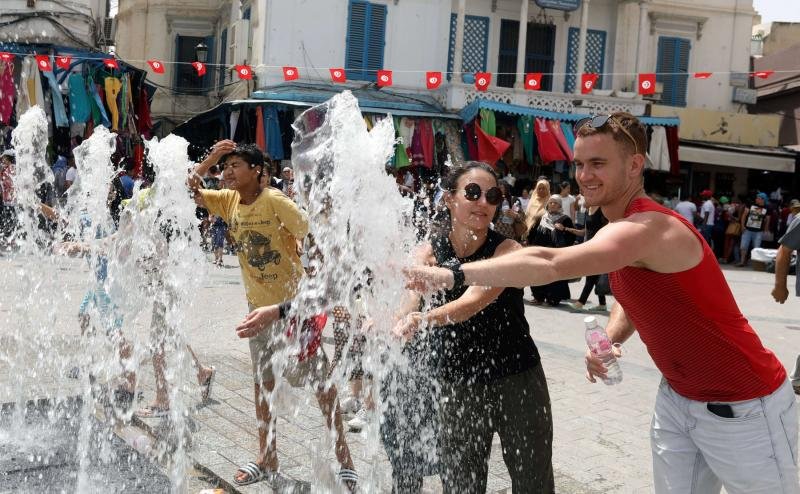Southern Algeria likely registered Africa’s all-time highest temperature, hitting 51.3 degrees Celsius on July 5, part of a weeks-long heatwave that has turned North African cities into tinderboxes.
The record temperatures were made worse by breakdowns in water supplies and rolling power outages, which prompted residents throughout the region to demand government action.
In Tozeur, an oasis town on the edge of the Sahara in Tunisia, temperatures reached 49 degrees on July 5 and in Morocco’s south-eastern town of Assa-Zag 48-degree temperatures were recorded.
Morocco’s southern town of Semara had held the record for the continent’s highest temperature, recording 50.7C on July 13, 1961.
The stifling heat and its effect on water and power services were a startling forecast of the climate changes expected to rattle the Maghreb in the coming decades, experts said.
While individual cases of extreme temperatures cannot necessarily be attributed to climate change, the extended length of North Africa’s heatwave suggests a general climate trend that is exacerbated by rising concentrations of greenhouse gases, the World Meteorological Organisation said in a statement.
Tunisian environment and climate expert Hamdi Hached said the longest heatwaves — periods in which temperatures stayed about 35C — in the Maghreb had lasted 11-14 days in the 1950-1960s. However, in recent years, temperatures have stayed above 35C in some areas for more than 28 consecutive days and they are expected to remain above that temperature for more than 32 days this year.
“This phenomenon is harmful as it causes evaporation of the water in the dams of the region,” Hached said.
In Algeria, which is expected to be hit hardest by climate change in North Africa, life has been fundamentally altered by high temperatures, residents said.
“Beginning at 8am no one can leave the house,” Ali Hamdane, a resident in Ouargla, told state television. “We cannot go to work. We cannot reach the hospital in cases of emergency. All aspects of daily life and business grind to a standstill.”
Algeria’s record heat on July 5 strained southern cities’ ageing power grids and water supply systems as residents tried to stay cool, further frustrating a local population that has long complained of government neglect.
Protesters took to the streets in the south-western town of Bechar, southern cities of Adrar, Touggourt, Beji Mokhtar, Tamanrasset and Ouargla, site of Algeria’s largest oil field, voicing discontent over the disruption of water and power services, local media reported.
In Djelfa, protesters surrounded visiting Interior Minister Noureddine Bedoui and his delegation demanding action. This came after unrest in southern Algeria since 2013 over a lack of development and economic growth.
Algerian Energy Minister Mustapha Guitouni said the state’s power utility Sonelgaz worked nonstop to repair equipment damaged by extreme heat.
“It is like that. It is hot because it is hot. It is climate change. No person can control the circumstances of climate change,” Guitouni told state media.
In Tunisia, severe heat pointed out water supply problems that limited drinking water for both humans and livestock. Villagers from el-Ksasba in the coastal region of Mahdia blocked traffic on a highway linking Tunis to Sfax to protest water supply cuts that led to cattle dying from thirst. Breeders in the area rely on running water to nourish animals because most well water is too saline.
The water scarcity, experts said, drives home Tunisia’s urgent need to upgrade its water supply system.
The World Resources Institute ranked Tunisia 33rd of countries most at risk of a water crisis. It could go dry by 2040 if authorities fail to make progress on delayed water projects, including constructing dams and improving urban and agricultural planning, the institute said.
Tunisia’s junior agriculture minister said Tunisia, where water has long been scarce, suffered an average deficit of 100 million cubic metres per year over the past three years because of drought.
Agriculture Minister Samir Taieb said the country needed a “new strategy” for water use to compensate for droughts brought on by predicted drops in rainfall.
Tunisian water expert Jalloul Sghari, who teaches at Paris Descartes University, said Tunisia could compensate for the loss in rainfall by building a complex network of water pipelines from the Medjerda River in northern Tunisia to southern regions.
Such a project would help Tunisia resolve its water scarcity problem and provide up to 600,000 economically efficient jobs, he argued in his new book, “Emergency Economic Plan for Tunisia.”
Morocco, despite building numerous dams, has also experienced water shortages, especially in the village of Zagora south of the Atlas Mountains, where residents protested perceived government neglect.
“The situation is made critical in the area. It is a daily suffering for the inhabitants,” said Atmane Rizkou, head of Zagora’s Human Rights Moroccan Association chapter.
The increase in water consumption caused by industrial and agricultural development led Moroccan King Mohammed VI to urge the government to prioritise the water issue.
“My keenness to improve social conditions and tackle economic challenges is second only to my determination to preserve and develop our country’s strategic resources, particularly water. Indeed, the latter plays a fundamental role in development and stability,” King Mohammed VI said.
TunisianMonitorOnline (The Arab Weekly,Lamine Ghanmi)
)




